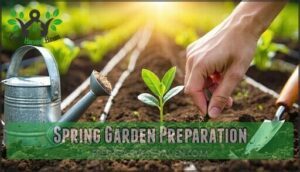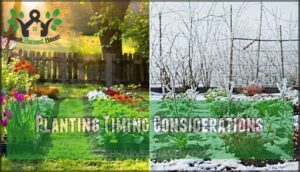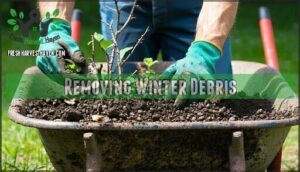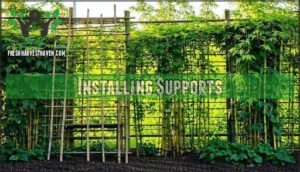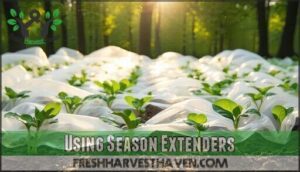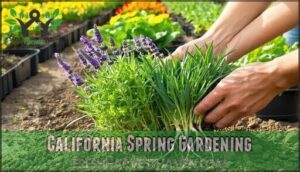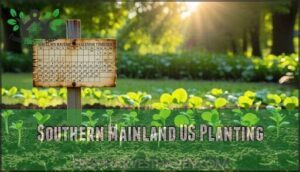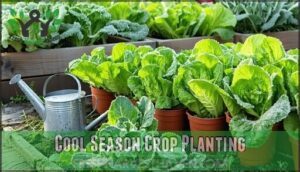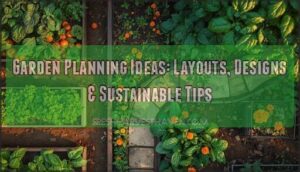This site is supported by our readers. We may earn a commission, at no cost to you, if you purchase through links.
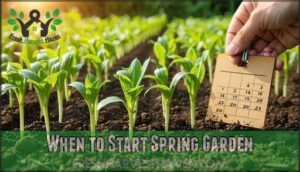
Typically, you’ll begin by starting seeds indoors 4-6 weeks before the last frost date.
For cool-season crops like broccoli and kale, start them indoors in late February to early March.
Then, in mid-to-late March, direct sow peas, spinach, and other hardy crops outdoors.
The key is to time it right for your region’s climate, so you’ll want to check your specific growing zone and plan accordingly, and that’s just the beginning of planning your perfect spring garden with the right climate and growing zone.
Table Of Contents
- Key Takeaways
- Spring Garden Preparation
- When to Start Spring Garden
- Planting Timing Considerations
- Garden Bed Readiness
- Regional Spring Gardening
- Frequently Asked Questions (FAQs)
- When to start a garden?
- Is spring a good time to start a garden?
- When should you plant a Spring Garden in California?
- When is the best time to plant a garden?
- How do you plant a Spring Garden?
- When is the best time to plant spring crops?
- What month is a good month to start a garden?
- When to start clearing a garden for spring?
- What is the gardening 3 year rule?
- When can I start gardening after winter?
- Conclusion
Key Takeaways
- You’ll start your spring garden by checking your growing zone and climate to determine the perfect start date for your region, usually 4-6 weeks before the last frost date.
- You should prepare your garden beds by clearing away winter debris, adding organic matter like compost, and installing supports for climbing crops like beans and peas.
- You’ll want to time your plantings perfectly, considering factors like soil temperature, frost dates, and microclimate effects, to give your garden the best chance of success.
- You can use techniques like succession planting, crop rotation, and season extenders to maximize your spring garden’s potential and ensure a continuous harvest throughout the growing season.
Spring Garden Preparation
You’re getting ready to start your spring garden, and timing is vital. As you prepare, you’ll need to determine your growing zone and understand how climate influences your garden’s success.
Timing is everything when starting your spring garden
Determining Growing Zones
Every smart gardener starts with the basics:
- Grab the USDA Zone Map to find your growing zone—think of it as your plant zone guide.
- Check Frost Dates and mark your last frost date on a planting calendar for spring.
- Notice subtle Microclimates and Climate Variations—your neighbor’s yard might’ve a different spring planting date!
Understanding the average winter temperatures is essential for plant selection.
Understanding Climate Influences
Your USDA growing zone provides the foundation, but microclimate effects and local weather patterns create the real story.
A south-facing slope might warm two weeks earlier than a shaded valley, even in the same zone.
Track your specific frost dates over several years—they’ll often vary from published averages.
Your plant zone guide becomes more accurate when you combine zone hardiness data with your backyard’s unique conditions.
When to Start Spring Garden
Once you’ve prepared your garden beds and understood your growing zone, you’ll need to determine the perfect timing for your spring garden start.
The key lies in understanding how frost date impact, soil temperature matters, and microclimate considerations work together. Your last frost date serves as the foundation for your planting calendar spring. However, don’t treat it as gospel—local weather patterns can shift this date by weeks.
Check seed packet guidance for specific timing, as different vegetables have unique temperature requirements. Here’s your spring planting dates checklist:
- Monitor soil temperature – Most seeds need 40-50°F soil to germinate properly
- Track local weather forecasts – Late cold snaps can damage tender seedlings
- Observe your yard’s microclimates – South-facing slopes warm faster than shaded areas
- Use your garden planting guide – Reference regional timing charts for your specific zone
- Plan succession plantings – Stagger sowings every 2-3 weeks for continuous harvests
When plant vegetables timing feels uncertain, remember that nature gives subtle clues. Soil that crumbles in your hand rather than forming mud balls signals readiness for cool-season crops. Many gardeners find success when starting seeds indoors before the last frost.
Planting Timing Considerations
Perfect timing makes all the difference between a thriving garden and one that struggles against the elements.
Timing is everything in gardening, making all the difference in a thriving garden
You’ll want to take into account seed starting schedules, succession planting strategies, and regional climate patterns to maximize your spring garden’s potential, considering complete concepts to ensure the best outcome.
Seed Starting Basics
Your seed starting time acts like a countdown timer—get it right, and you’ll have healthy seedlings ready for transplant. Most vegetables need 6-8 weeks of indoor duration before your last frost date, but peppers and eggplants require 8-10 weeks for proper development.
| Plant Type | Indoor Duration | Direct Sowing Option | Frost Protection |
|---|---|---|---|
| Tomatoes | 6-8 weeks | Not recommended | Reemay covers extend planting |
| Peppers/Eggplants | 8-10 weeks | Not recommended | Wall of water protectors |
| Leafy Greens | 4-6 weeks | Yes, after soil warms | Row covers for cold snaps |
| Herbs | 6-8 weeks | Yes, for hardy types | Season extenders helpful |
Calculate your sowing dates by counting backward from your area’s frost dates. Remember, hardening off takes another week before transplanting outdoors. To encourage strong early growth, consider using specialized seedling lights for healthy seedlings and to promote strong early growth with the help of specialized lights.
Succession Sowing Strategies
You’ll use succession planting for continuous harvest and extended yields.
Staggered planting optimizes resources, allowing for crop rotation and a well-planned garden timing schedule, ensuring a bountiful harvest through strategic seed starting and garden planning techniques.
This approach helps to extend summer harvest by planting crops in intervals.
Moon Phase Influences
After succession sowing, let’s talk Lunar Planting. Gardeners have used Moon Cycles and the Biodynamic Calendar to fine-tune planting schedules for generations.
You might chuckle, but Planting Astrology suggests seeds take off best with tides influence, especially before the Full Moon.
According to some, the Moon’s gravitational pull affects soil moisture levels, which can aid in germination. Let your spring garden ride these rhythms, adjusting your planting season just after the last frost date to catch the moon’s magic.
Regional Planting Timelines
While moon phases offer planting guidance, your garden planting schedule depends heavily on Zone-Specific Calendars and regional variations.
Microclimate Adjustments become essential when frost date planting differs from standard recommendations. Regional Soil Differences affect your best time plant decisions, making local knowledge invaluable for successful crop timing.
Many gardeners find a regional planting calendar helpful.
- Zone-Specific Calendars guide your planting season with precision timing
- Frost Date Variations can shift schedules by weeks in neighboring areas
- Regional Gardening expertise helps navigate local growing conditions
- Crop Selection Timing maximizes harvest potential in your specific zone
Garden Bed Readiness
Before your seedlings can thrive, your garden beds need the right foundation to support healthy growth.
You’ll want to clear away winter’s leftovers and create an environment where plants can establish strong roots from day one, allowing them to thrive with a good foundation.
Removing Winter Debris
Now’s the perfect time to tackle your spring garden cleanup checklist.
Clear away dead leaves, branches, and plant debris that accumulated over winter. This debris can harbor pests and diseases that’ll damage your new plants.
Decomposing matter creates acidic conditions that hurt soil health. Use clean tools to prevent spreading problems between garden beds.
Proper disposal prevents extensive winter damage. Compost healthy materials but dispose of diseased debris safely in municipal waste to avoid diseased debris.
Adding Organic Matter
Once you’ve cleared away debris, your beds are ready for the soil enrichment that sets the stage for healthy plant growth.
Adding organic matter like compost benefits your garden by improving soil structure and providing slow-release nutrients.
Apply composted manure in spring or fresh manure in fall for ideal nutrient cycling. Layer organic amendments 2-3 inches deep, then work them into the top 6 inches of soil.
Consider testing your soil to adjust soil pH levels as needed. This soil preparation creates the foundation your plants need to thrive.
Installing Supports
You’ll want to install trellises and garden structures before planting climbing crops like beans, peas, and cucumbers.
Choose sturdy support materials such as bamboo poles, metal stakes, or wooden frames that can handle wind and plant weight.
DIY supports work great for vertical gardening projects.
Position structures carefully to avoid disturbing plant roots later, and this early installation makes plant training much easier throughout the growing season.
Using Season Extenders
Season extenders act like protective blankets for your spring garden, shielding cool-season crops from unexpected frost while creating beneficial microclimates.
Row covers offer excellent frost protection and pest control at minimal cost.
Cold frames provide superior heat retention methods through glass or plastic panels, and these extender material choices help you start planting weeks earlier, giving your garden a head start on the growing season with the use of row covers.
Regional Spring Gardening
Your garden’s spring schedule depends on where you live, since different regions have vastly different frost dates and growing seasons.
Understanding your specific area’s climate patterns helps you time plantings perfectly, whether you’re dealing with California’s mild winters or the Deep South’s early spring warmth.
California Spring Gardening
California’s diverse microclimates create unique spring garden opportunities across zones 5-11.
You’ll start warm-season vegetables like tomatoes in February indoors, while cool-season crops like peas can be direct sown in December-January.
The state’s Mediterranean climate supports year-round growing in coastal areas. Many gardeners also find success when they divide perennials for plant rejuvenation.
- Drought-tolerant plants like lavender and native manzanita thrive in California’s dry summers with minimal irrigation techniques
- Wildflower blooms peak in spring when you time plantings with natural rainfall patterns for maximum growth
- Pest management becomes easier when you plant during cooler months, reducing insect pressure on young seedlings
- Early spring planting of succession crops every 1-2 weeks guarantees continuous harvests through the growing season
Southern Mainland US Planting
In southern gardening, you’ll find the ideal planting time for warm-season crops varies by region.
Check frost dates and soil temperatures to plan your spring garden, considering regional variations and planting calendars for the best results in the Southern Mainland US, focusing on complete concepts.
Cool Season Crop Planting
As you plan your spring garden, consider cool-season crops.
- Frost Tolerance
- Germination Temperatures
- Bolting Prevention
They thrive in cooler temperatures, making them perfect for early spring planting, and are a great addition to your vegetable planting guide and spring garden checklist.
Advanced Planning Techniques
You’ll master garden planning by considering crop rotation, pest management, and water conservation.
Ensuring ideal planting time based on soil temperature and USDA Plant Hardiness Zones, to create a thriving microclimate design in your spring garden.
Frequently Asked Questions (FAQs)
When to start a garden?
You’ll start gardening when soil temperatures rise, usually 6-8 weeks before the last frost date, depending on your region and the type of plants you’re growing outdoors.
Is spring a good time to start a garden?
You can begin a garden in spring, as it offers ideal conditions for various plants to thrive, with mild temperatures and increased daylight hours.
When should you plant a Spring Garden in California?
You’re probably thinking California’s always sunny, but for a spring garden, you’ll want to plant after the last frost date, usually late February to early March, depending on your zone.
When is the best time to plant a garden?
You’ll want to plant when the soil temperature reaches 40°F, typically after the last frost date, to guarantee the best growing conditions for your garden.
How do you plant a Spring Garden?
Don’t worry if you’re new to gardening, you’ll get the hang of it. You plant a spring garden by preparing soil, choosing suitable plants, and following a customized planting schedule.
When is the best time to plant spring crops?
You’ll plant spring crops 6-8 weeks before the last frost date, considering your region’s climate and specific growing zone to guarantee healthy growth and minimize frost damage risks.
What month is a good month to start a garden?
You’re the conductor of your garden orchestra, and March or April is a good month to start playing, as the weather begins to warm up and frost risk decreases.
When to start clearing a garden for spring?
You’ll start clearing your garden for spring when soil can be worked, usually after the last frost date, removing debris and preparing beds for new growth and planting.
What is the gardening 3 year rule?
You’ll notice most perennials follow the gardening 3-year rule, taking three years to establish, flourish, and reach full potential in your carefully tended garden space.
When can I start gardening after winter?
You’re itching to ditch winter blues, and surprisingly, it’s time to get gardening, checking your zone’s last frost date to begin.
Conclusion
As you begin planning, remember timing is everything when deciding when to start your spring garden.
You’ll be sowing seeds in no time, so check your growing zone and climate to determine the perfect start date for your region, making the most of your when to start spring garden journey, considering everything.
- https://planthardiness.ars.usda.gov/
- https://store.almanac.com/garden-journal?utm_source=edit&utm_medium=article&utm_campaign=planting-map
- https://www.instagram.com/ginamicheleblog/
- https://www.americanmeadows.com/content/usda-zone-map?srsltid=AfmBOopnOy-et3WIHYuwMISsDhIdRMjhdVDv86N5xLEzTJexFgwue7OP
- https://www.groworganic.com/pages/what-is-my-growing-zone?srsltid=AfmBOorUjP4uWUx-sL17TqvFCQehNaVZychTplo4vpdAF3INHb1yDeDz

